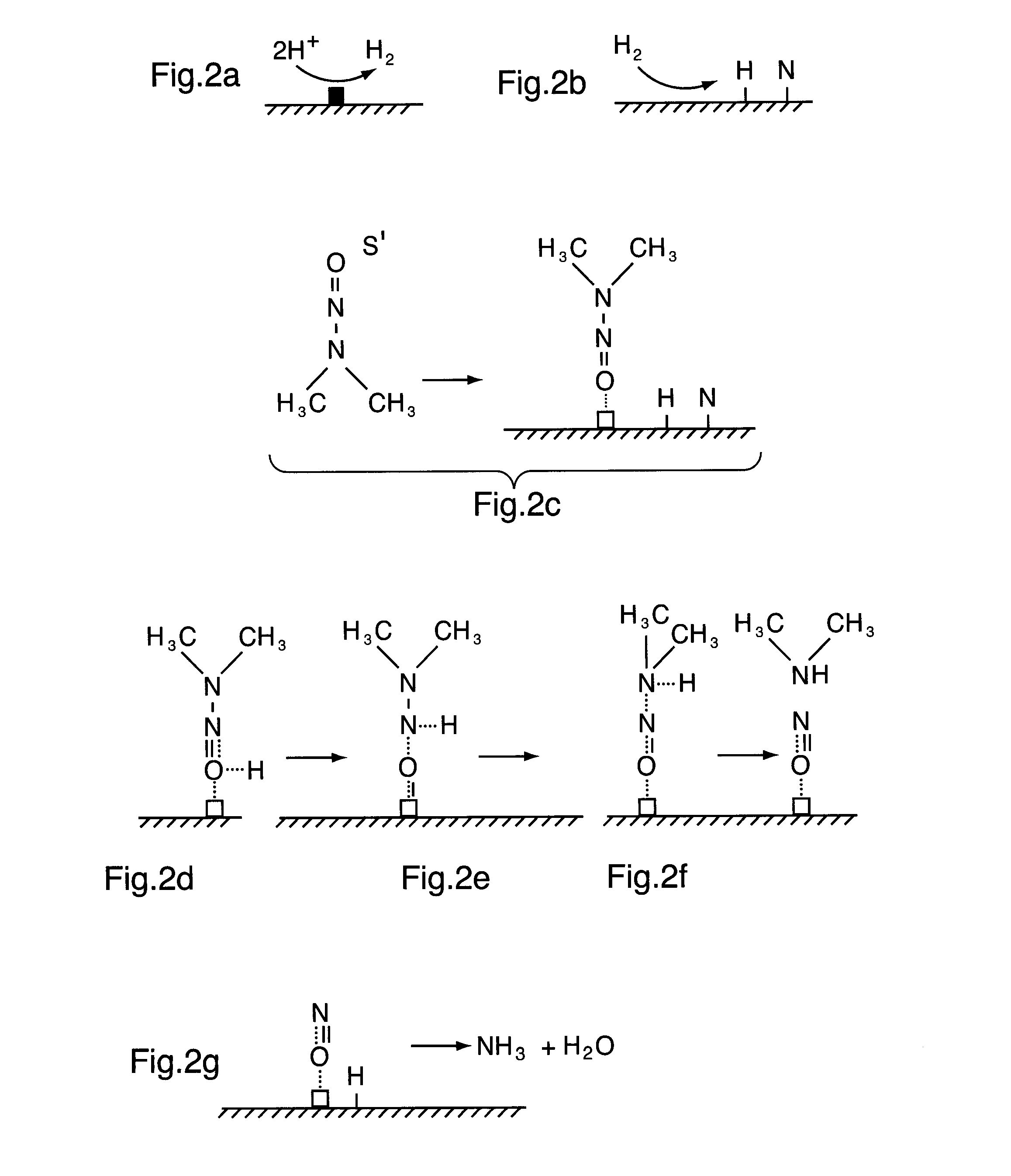Photocatalyst composition of matter
a technology of photocatalysts and compositions, applied in the direction of organic compounds/hydrides/coordination complexes, physical/chemical process catalysts, metal/metal-oxides/metal-hydroxide catalysts, etc., can solve the problems of reducing the efficiency of uv transmission, high uv dose, and high cost of methods, so as to reduce the amount of equipment and energy, reduce the amount of toxic compounds, and reduce the effect of uv dos
- Summary
- Abstract
- Description
- Claims
- Application Information
AI Technical Summary
Benefits of technology
Problems solved by technology
Method used
Image
Examples
example 1
Preparation of a Multifunctional Ni / NiO / NaTaO3:La
[0150]In this Example, there is described preparation of a multifunctional catalyst and testing of that multifunctional catalyst in a photoreactor for the catalytic reduction of N-Nitrosodimethylamine (NDMA). Some basic background on the preparative method the multifunctional catalyst may be obtained from H. Kato, H. Asakura and A. Kudo (2003), J. Am. Chem. Soc., 125, 3082 [Kato et al.] which describes a La doped NiO / NaTaO3 catalyst reported to have the highest activity for hydrogen production from water splitting in the UV range (@ 270 nm)—see A. Kudo and Y. Miseki (2009), Chem. Soc. Rev., 28, 253.
[0151]First the semiconductive photocatalyst, which serves as a support material for the dispersed catalytic hydrogenation sites, is prepared. The follow procedure is used:[0152]1. La2O3, Na2CO3 and Ta2O5, all of high purity (>99%) are mixed together in the ratio Na:La:Ta (1-X):X:1 where X=0.02.[0153]2. Sodium is added in an amount to provi...
example 2
Catalytic Reduction of NDMA from the Reaction of Hydrogen Generated In Situ from the Photocatalytic Water Splitting Using a Mixture of 2 Catalysts (Raney and Ni and NiO / NaTaO3:La Catalysts) Slurried in a Batch Photoreactor
[0176]In this example, 4 grams of a water splitting photocatalyst (Catalyst A) is prepared as described in Example 1, Steps 1-12 corresponding to the synthesis of a NiO / NiO / NaTaO3:La with a NiO content of 0.2 wt % and an La content of 2 mol %. A second catalyst (Catalyst B) is used to facilitate catalytic hydrogenolysis of NDMA in the presence of hydrogen. Catalyst B is a commercially available Raney nickel catalyst (87% Ni, 8% Al) with a specific surface area of 100 m2 / g and pore volume of 0.11 cm3 / g as described in A. J. Frierdich, C. E. Joseph and T. J. Strathman (2009), Appl. Catal. B., 90, 175.[Frierdich et al.].
[0177]A small photoreactor is charged with 400 mL of water. 4 grams of catalyst A and 0.2 g of Catalyst B are charged to the reactor and slurried. The...
example 3
Hydrodechlorination of Trichloroethylene (TCE) from the Reaction of Hydrogen Generated In Situ from the Photocatalytic Splitting of Water Using a Slurry of Two Catalysts
[0185]A similar experiment to that described above in Example 2 is conducted using the same batch photoreactor initially charged with 400 mL of water and 4 grams of Catalyst A. In addition, 4 grams of a commercially available catalyst (Catalyst C) consisting of 1 wt % Pd / Al2O3 with a specific surface area of 177 m2 / g described by M. O. Knutt, J. B. Hughes and M. S. Wong (2005) Environ. Sci. Technol., 39, 1346 [Knutt et al.].
[0186]The water in the photoreactor is initially spiked with trichloroethylene (TCE) a known carcinogen and contaminant found in groundwater. The initial TCE concentration is 100 ppm. The catalytic hydrodechlorination of TCE is carried out in the reactor from the reaction of hydrogen produced in situ from the photocatalytic splitting of water. It is believed that the catalyst will be irradiated by...
PUM
| Property | Measurement | Unit |
|---|---|---|
| quantum efficiencies | aaaaa | aaaaa |
| band gap | aaaaa | aaaaa |
| non-photocatalytically active | aaaaa | aaaaa |
Abstract
Description
Claims
Application Information
 Login to View More
Login to View More - R&D
- Intellectual Property
- Life Sciences
- Materials
- Tech Scout
- Unparalleled Data Quality
- Higher Quality Content
- 60% Fewer Hallucinations
Browse by: Latest US Patents, China's latest patents, Technical Efficacy Thesaurus, Application Domain, Technology Topic, Popular Technical Reports.
© 2025 PatSnap. All rights reserved.Legal|Privacy policy|Modern Slavery Act Transparency Statement|Sitemap|About US| Contact US: help@patsnap.com



